It’s National Poetry Month, an observance begun by the Academy of American Poets in 1996. Looking for ways to celebrate? Possibilities abound, and there’s no better way to begin than with The Walking Classroom’s podcasts on poets and poetry topics!
Wondering how to support your study of the genre? Introduce your students to additional examples, and incorporate a poem a day. Better yet, bring some books into the mix!
Some Program 4 Picks . . .
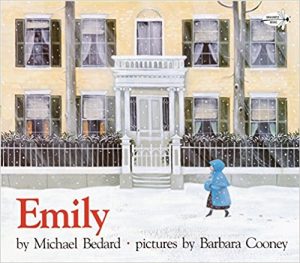 Explore the world of reclusive poet Emily Dickinson (4-#38, Combined-#28). Use books to have a look into her life, or take a peek into her poems! Start with Michael Bedard’s picture book, Emily (580L). Beautifully illustrated by Barbara Cooney, it presents a fictionalized meeting between Emily Dickinson and a young neighbor.
Explore the world of reclusive poet Emily Dickinson (4-#38, Combined-#28). Use books to have a look into her life, or take a peek into her poems! Start with Michael Bedard’s picture book, Emily (580L). Beautifully illustrated by Barbara Cooney, it presents a fictionalized meeting between Emily Dickinson and a young neighbor.
Fascinated by this account? Then peruse another picture book! Emily Dickinson’s Letters to the World (580L), written and illustrated by Jeanette Winter, shares the story of how Emily Dickinson’s poems were discovered. Although small by picture book standards (at just 6” by 7.8”), the book’s dimensions mimic those of the hand-bound booklets the poet herself created!
If you are ready to encounter another poet, learn about Langston Hughes (4-#16, Combined-#34). Begin with a biography, such as Langston Hughes: Young Black Poet by Montrew Dunham (860L), and follow up with some poems from picture book editions of his works!
- The Dream Keeper and Other Poems (illustrated by Brian Pinkney)
- I, Too, Am America (illustrated by Bryan Collier)
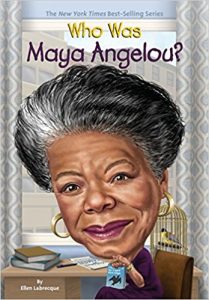 Meet Maya Angelou (4-#17, Combined-#37) through Ellen Labrecque’s Who Was Maya Angelou? (900L). If you need a quick read, Lisbeth Kaiser’s Maya Angelou is a great option. This simple yet informative biography is part of the “Little People, Big Dreams” series. Then, to bring Angelou’s poetry to life, try an activity based on one of her poems!
Meet Maya Angelou (4-#17, Combined-#37) through Ellen Labrecque’s Who Was Maya Angelou? (900L). If you need a quick read, Lisbeth Kaiser’s Maya Angelou is a great option. This simple yet informative biography is part of the “Little People, Big Dreams” series. Then, to bring Angelou’s poetry to life, try an activity based on one of her poems!
Poets and Pulitzer Prize Winners!
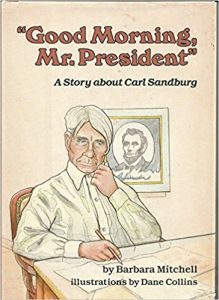 Introduce your students to one (or two!) Pulitzer Prize winners through a podcast and book pairing. Learn about Carl Sandburg (4-#24, Combined-#35), and read Barbara Mitchell’s Good Morning Mr. President: A Story about Carl Sandburg (780L). This book presents a fictionalized portrait of the three-time Pulitzer Prize winner, who was renowned for his biography of Abraham Lincoln (for which he won one of his awards) and for his poetry!
Introduce your students to one (or two!) Pulitzer Prize winners through a podcast and book pairing. Learn about Carl Sandburg (4-#24, Combined-#35), and read Barbara Mitchell’s Good Morning Mr. President: A Story about Carl Sandburg (780L). This book presents a fictionalized portrait of the three-time Pulitzer Prize winner, who was renowned for his biography of Abraham Lincoln (for which he won one of his awards) and for his poetry!
Enjoy the natural imagery of Robert Frost (4-#23, Combined-#33), and explore two beautifully illustrated books. Each focuses on a different Frost poem, so your students can then compare and contrast!
- Birches (illustrated by Ed Young)
- Stopping by Woods on a Snowy Evening (illustrated by Susan Jeffers)
How about Some Humor?
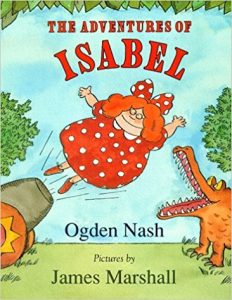 Interject some laughs into your study of poetry, and read some verse by Ogden Nash (4-#40, Combined-#36). Engage your crew with books built around an individual poem. Choose from The Adventures of Isabel (illustrated by James Marshall) or The Tale of Custard the Dragon (illustrated by Lynn Munsinger). For a different approach, dive into Ogden Nash’s Zoo (edited by Roy Finamore and illustrated by Etienne Delessert). This collection features verses about . . . you guessed it! Animals!
Interject some laughs into your study of poetry, and read some verse by Ogden Nash (4-#40, Combined-#36). Engage your crew with books built around an individual poem. Choose from The Adventures of Isabel (illustrated by James Marshall) or The Tale of Custard the Dragon (illustrated by Lynn Munsinger). For a different approach, dive into Ogden Nash’s Zoo (edited by Roy Finamore and illustrated by Etienne Delessert). This collection features verses about . . . you guessed it! Animals!
Equally entertaining are the works of Jack Prelutsky (4-#39, Combined-#38). A prolific poet and perennial favorite, Prelutsky has been publishing poems for children since the 1960s! Incorporate one of these thematically based collections into your class activities.
- Behold the Bold Umbrellaphant and Other Poems (illustrated by Carin Berger)
- Good Sports: Rhymes about Running, Jumping, Throwing, and More (illustrated by Chris Raschka)
- Be Glad Your Nose Is on Your Face and Other Poems (illustrated by Brandon Dorman)
Inspired by his writing, and looking for some tips? Check out Pizza, Pigs, and Poetry: How to Write a Poem, published by Prelutsky in 2008, then put those newfound skills to practice!
All About Anthologies
You can also introduce your students to a variety of these poets’ works through anthologies. Both MoonDance Press’ “Poetry for Kids” series and Sterling Publishing’s “Poetry for Young People” series include many of these poets. And the experience goes beyond the poems themselves, as the illustrations are perfectly paired with the text!
. . . and Program 5 Possibilities!
Use podcasts found in Program 5 to explore figurative language and other literary elements featuring prominently in poetry.
- Simile and Metaphor (4-#11, 5-#72, Combined-#4)
- Alliteration & Personification (5-#67, Combined-#5)
- Rhyme Scheme, Meter and Verse (4-#9, Combined-#9)
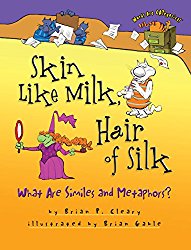 There are books a-billion (okay, that’s an exaggeration!) full of figurative language like simile and metaphor. My personal favorite? Skin Like Milk, Hair of Silk: What Are Similes and Metaphors? from Brian P. Cleary’s “Words Are Categorical” series! You can also address alliteration and personification with the help of texts. Use samples from selected poems, or pick a peck of picture books to help you out!
There are books a-billion (okay, that’s an exaggeration!) full of figurative language like simile and metaphor. My personal favorite? Skin Like Milk, Hair of Silk: What Are Similes and Metaphors? from Brian P. Cleary’s “Words Are Categorical” series! You can also address alliteration and personification with the help of texts. Use samples from selected poems, or pick a peck of picture books to help you out!
When you’re finished sharing samples, challenge your students to devise their own examples! Still seeking more poetry material? Check out other literary elements and learn some additional poetry terminology too!
Some Other Suggestions . . .
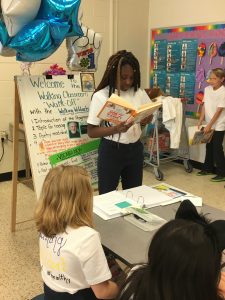 By now your students are fairly knowledgeable about poetry, and who knows? They may even be itching to put pencil to paper (or fingers to keyboard) to create some verse of their own. Focus on features like alliteration or similes and metaphors, or switch the focus to different poetic forms. Why not have them try their hand at a cinquain or a haiku? You can even entertain your students with a lesson on onomatopoeia!
By now your students are fairly knowledgeable about poetry, and who knows? They may even be itching to put pencil to paper (or fingers to keyboard) to create some verse of their own. Focus on features like alliteration or similes and metaphors, or switch the focus to different poetic forms. Why not have them try their hand at a cinquain or a haiku? You can even entertain your students with a lesson on onomatopoeia!
Need a good closing (and collaborative!) project? Compile your own classroom anthology of your students’ work! Then, schedule a poetry reading, and let them share their individual creations with an audience.
Be sure to be on the lookout for the next post in this series (coming in June). Not only will we offer some suggestions to support your STEM studies, we’ll also share more literary links to partner with The Walking Classroom’s podcasts!


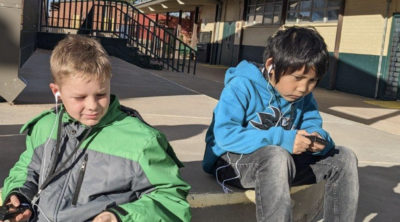

My fourth grader listens to the “Similes and Metaphors” to helped the review for the state accountability testing. This provided a wonderful review and also allow them to be outside enjoying a beautiful day. It is wonderful when needed review can be so pleasant.
During our 4th grade poetry unit, we used quite a few of our podcasts such as “Rhyme Scheme, Meter, and Free Verse”, “Similes and Metaphors”, “Robert Frost”, and “Langston Hughes” just to name a few. The children enjoyed each podcast, and they looked forward to seeing who would make the highest score on the quizzes.
We love it!